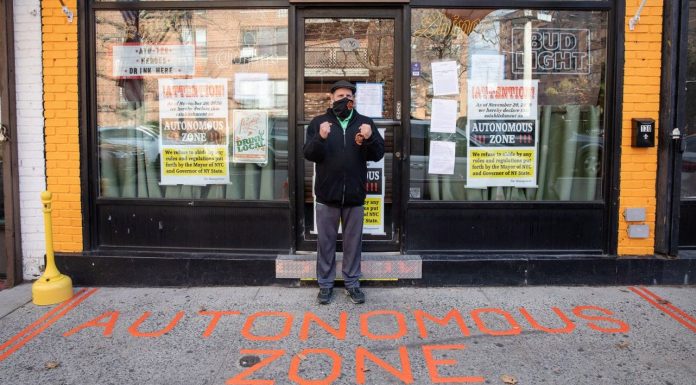(American Institute for Economic Research) With small business owners struggling under the weight of lockdown orders, Los Angeles and New York City drew intense criticism recently for closing restaurants again. Los Angeles issued an outdoor dining ban on top of its existing indoor dining ban and New York an indoor dining ban which, with the coming winter cold, by default ends outdoor dining as well.
Both these cities have been especially heavy-handed with their application of public health interventions, issuing different policies with alarming frequency. Such behavior in itself leads to confusion and turmoil as communities are forced into situations to which they can never adapt financially or socially.
In light of growing knowledge about Covid-19 as well as our experience with the outcomes of public health interventions, restaurant closures should not be seen as a sensible policy. Not only do they cause tremendous economic and social trauma, but they also lack strong scientific backing and legal consistency. Closing restaurants, especially at this stage in the pandemic, will not only lead to adverse public health consequences, but will also undermine the rule of law.
The Faulty Science Behind Restaurant Closures
The main rationale behind closing restaurants pertains to stemming the recent upticks in Covid-19 cases and deaths. Part of this could be attributed to the fact that this time of the year is flu season, and it was correctly predicted earlier in the year that winter would bring a resurgence of the virus.
Another explanation cites Thanksgiving family gatherings as another large contributor, as individuals gathered in spaces where guidelines were unlikely practiced. These are all reasonable explanations and one can go in many directions with this information, but closing restaurants is not one of them.
Although restaurants are sometimes labeled “superspreaders” according to contact tracing published by the state of New York, restaurants and bars only account for 1.43% of transmissions. Such data does not seem to be an anomaly as another report from Marion County, Oregon suggests that only 1% of transmissions could be traced to restaurants and bars.
The Salem Reporter writes,
“Craig Pope, Polk County commissioner, said he wants to help Oregon get the virus’ spread under control, but it’s hard for him to see state restrictions as science-based when the county’s health department hasn’t tied Covid spread back to restaurants.”
According to contact tracing, 74% of new cases are attributed to household gatherings where individuals are less cautious and health precautions are less prevalent. This would explain the uptick in cases post-Thanksgiving, but closing restaurants would essentially make such gatherings more prevalent. Eater writes,
“By comparison, private and social gatherings accounted for nearly 74 percent of COVID-19 cases tracked by the state between September and the end of November, and the restaurant industry placed fifth overall among the various industries and activities contributing to the spread of the virus.”
Closing restaurants will likely shift the density of infections towards other venues such as home gatherings and grocery stores. The late Dr. Donald Henderson wrote the following about limiting large public events in response to influenza, another highly infectious respiratory disease:
“Intuitively, this would appear to be a helpful adjunct to reduce contacts among people and so mitigate the effects of the epidemic. However, individuals normally have a great many contacts throughout the community on a daily basis: shopping in stores, attending church, traveling on public transport, and so on. Recognizing that the spread of influenza is primarily by person-to-person contact, any one individual, even in a large gathering, would have only a limited number of such close encounters with infected people.”
According to a recent study published by researchers at Stanford University, highly broad and disruptive policies such as restaurant closures are inferior to more precise policies such as occupancy limits. It also found that restrictive policies such as stay at home orders lead to increased transmission rates upon reopening, likley due to a backload of pent up demand.



